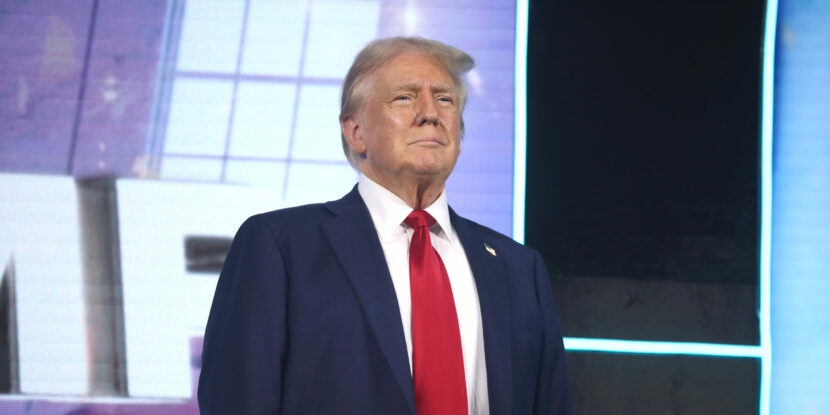President Donald J. Trump’s ambitious plan to use broad and targeted tariffs to protect and restore American industry is drawing bizarre counterarguments from his opponents, both in the Never Trump camp and among Democrats. Trump announced a plan that could see tariffs of upwards of 20 percent placed on imported goods into the U.S. earlier this week, with higher tariffs reserved to deal with specific industries.
Critics of Trump’s tariff plans are raising a wide range of objections, many of which are nonsensical upon closer inspection. The National Pulse has put together a brief overview of why nations use tariffs, their history, and how Trump’s critics get the monetary and fiscal impacts of tariffs very wrong.
WHAT IS A TARIFF?
At its most basic level, a tariff is just a form of taxation—but one that has specific impacts on a country’s imports and exports. The most common form of tariff is the protective tariff, which aims to either insulate or stabilize a crucial domestic industry in a given country from foreign competition. Tariffs can take the form of a fixed tax rate on imported or exported goods—meaning a constant set sum or percentage—or they can be applied at a variable rate that fluctuates with the tariff target’s value.
Broad or blanket tariffs are less common than industry or product-specific tariffs. However, they are still used by governments, especially against foreign nations that engage in unfair trade practices such as currency manipulation.
At the most basic level, the goal of a tariff is to dissuade the consumption of a foreign good instead of an identical or similar domestic good. Pushing consumption towards domestic products boosts the domestic economy, eases foreign competition pressures, and lowers a nation’s trade deficit. Additionally, tariffs are tools used to punish countries that engage in dumping, which means flooding foreign markets with artificially underpriced goods—often achieved through heavy state subsidies—to weaken or wipe out a rival nation’s domestic industry.
DO TARIFFS WORK?
Tariffs are one of many trade tools a nation uses to tilt international markets in their favor. In short, they do work and can benefit a nation dramatically. However, that is not to say there aren’t drawbacks.
For most of its history, the United States has maintained a wide range of tariffs as a matter of policy to promote and protect critical domestic industries. Prior to the ratification of the U.S. Constitution and the granting of taxing authority to Congress, tariffs were pretty much the only way the federal government could raise revenue. Tariffs also comprised a cornerstone of Alexander Hamilton’s economic blueprint as the U.S.’s first secretary of the treasury.
Throughout the 19th Century, tariffs were common in the U.S., helping to fuel the growth of American industry. Congress often instituted tariff measures in response to the dumping of foreign goods—such as when the British began flooding the U.S. markets with imports following The War of 1812.
However, the use of tariffs fell out of favor following the Smoot–Hawley Tariff Act of 1930 and the Great Depression—as many saw the law as exacerbating the economic depression’s effects. Post-Great Depression—and throughout the remainder of the 20th Century—import and export taxes remained relatively low. Populists and nationalists point to this period as one in which American jobs—accurately—began to shift overseas, especially following President Richard Nixon’s decision to lift foreign capital controls.
ARE TARIFFS INFLATIONARY?
The latest argument posited by critics of Donald Trump’s tariff plan is to harness inflationary fears among Americans in an attempt to falsely convince them that tariffs will make matters worse. Social media has been flooded with claims that the Trump tariff plan will only exacerbate inflation, with corporate media talking heads repeating the assertion as well. The claims are not remotely correct, however.
As noted above, tariffs are, in essence, taxes. Taxation is inherently deflationary as it either removes dollars from the U.S. monetary supply or creates ‘demand destruction’ by directly suppressing the demand for a good. By removing dollars from circulation through forms of taxation like income taxes, the upward pressure on prices created by an increasing monetary supply is reduced. Meanwhile, taxes—like a consumption-based sales tax or a tariff—increase the cost for a consumer or producer, reducing demand. In the latter instance, think of a tax on cigarettes—by taxing the sale at a high rate, the long-term goal of lawmakers is to reduce consumption.
It is important to note that there are instances where producers choose to absorb the increased cost of production caused by a tariff instead of passing it on to a consumer—especially in the context of maintaining market competitiveness.
While a tariff might appear to be inflationary in the very short term—it can raise prices—in the long term, the encouragement of domestic investment, stabilized production capacity, and sustainable consumption all reduce inflation and strengthen American industry.
Lastly, the claims that tariffs are inflationary fall absolutely flat on their face when one simply looks at the most infamous tariff policy in American history, Smooth-Hawley. Enacted in 1930, some contend the tariff policy exacerbated the Great Depression by setting off a cascade of retaliatory foreign tariffs against the U.S.—cratering domestic and foreign consumption and throwing the country into a deflationary cycle. While the timing of the tariff act likely contributed to some negative impacts, many economists now agree that Smoot-Hawley’s contribution to the deflationary crisis that kicked off the depression is significantly overblown.
EVENING THE FIELD.
But therein lies the problem for critics of Trump’s tariff plan; it cannot be both inflationary and deflationary—and historically, tariffs are deflationary. While there is always a risk of retaliatory tariffs, the U.S. currently has a relatively minimal tariff stance against foreign nations.
Meanwhile, countries like Japan, Mexico, and Germany already use tariff policies to tilt the auto manufacturing industry in their favor—with little resistance from the American government. Imposing higher tariffs on automobile imports from these countries would merely level the playing field for U.S. manufacturers.
Finally, there is the issue of China. While the communist state does engage in forms of tariff protectionism, its greatest weapon is currency manipulation. Using purchases and sales of U.S. Treasuries, the communist regime purposefully deflates their currency to ensure that domestic Chinese manufacturing costs remain artificially extremely low. This both encourages foreign investment in Chinese industry and drives multinational corporations to outsource their workforce to China. Broad-based tariffs on Chinese goods are—in short—the only way to combat just how radically the communist regime has tilted international trade in its favor.


